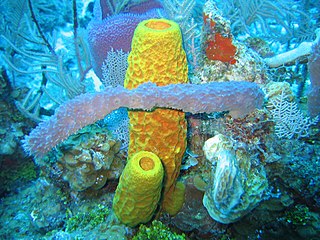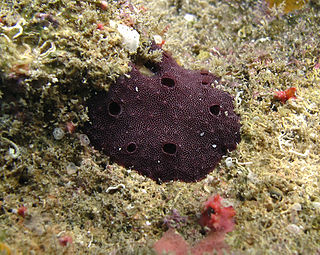
Demospongiae is the most diverse class in the phylum Porifera. They include 76.2% of all species of sponges with nearly 8,800 species worldwide. They are sponges with a soft body that covers a hard, often massive skeleton made of calcium carbonate, either aragonite or calcite. They are predominantly leuconoid in structure. Their "skeletons" are made of spicules consisting of fibers of the protein spongin, the mineral silica, or both. Where spicules of silica are present, they have a different shape from those in the otherwise similar glass sponges.

Polymastia is a genus of sea sponges containing about 30 species. These are small to large encrusting or dome-shaped sponges with a smooth surface having many teat-shaped projections (papillae). In areas of strong wave action, this genus does not grow the teat structures, but instead grows in a corrugated form.
Dame Patricia Rose Bergquist was a New Zealand zoologist who specialised in anatomy and taxonomy. At the time of her death, she was professor emerita of zoology and honorary professor of anatomy with radiology at the University of Auckland.
Hymeniacidon is a genus of sponges in the class Demospongiae. Some members of the genus are known to be mobile, achieving speeds of between 1 and 4 mm per day.
Stelletta is a genus of sea sponges belonging to the family Ancorinidae.

Clionaidae is a family of demosponges which are found worldwide. This family is known for parasitically boring holes in calcareous material such as mollusc shells and corals, using both chemical and mechanical processes.

Haliclona is a genus of demosponges in the family Chalinidae.

Darwinellidae is a family of sponges in the order Dendroceratida.

Spongia officinalis, better known as bath sponge, is a commercially used sponge. It is found throughout the Mediterranean Sea.
Mexichromis similaris is a species of sea slug or dorid nudibranch, a marine gastropod mollusk in the family Chromodorididae.

Arthur Dendy was an English zoologist known for his work on marine sponges and the terrestrial invertebrates of Victoria, Australia, notably including the "living fossil" Peripatus. He was in turn professor of zoology in New Zealand, in South Africa and finally at King's College London. He was a Fellow of the Royal Society.
Neenchelys microtretus is an eel in the family Ophichthidae. It was described by R.C. Bamber in 1915. It is a marine, temperate, water-dwelling eel which is known from the Red Sea, in the western Indian Ocean.
Cyril Crossland was an English zoologist.

Crella is a genus of marine demosponges in the family Crellidae.

Thorectidae is a family of sea sponges in the order Dictyoceratida.

Euplectellidae is a family of glass sponges (Hexactinellids) belonging to the order Lyssacinosa.

Syllis ramosa is a species of polychaete worm in the family Syllidae. It is found in the deep sea where it lives within the tissues of a sponge. It was the first branching polychaete worm to be discovered, with each worm having a single head and multiple anuses.

Geodia megastrella is a species of sponge in the family Geodiidae. It is found in the waters of the North Atlantic Ocean. The species was first described by Henry John Carter in 1876.

Mycale is a genus of demosponge with 240 recognised species in 11 subgenera. It has been a large genus with multiple subdivisions since it was first described in 1867.














